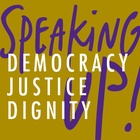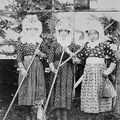Read Part 1 >>
4. After World War II: Aiming for equality for workers amid anti-communism
Union organization and labor disputes came to a standstill when America entered World War II. However, soon after the war ended, Hawaiian workers rose up to secure their legitimate rights. The ILWU (International Longshoremen's and Warehousemen's Union), the union for longshoremen that promoted labor organization, was led by a white American from the mainland, and around him came relatively young workers of Asian and Hawaiian descent who had been born in Hawaii. It was particularly groundbreaking that sugar plantation workers were organized under the ILWU, and it was young second-generation Japanese Americans who played an instrumental role in organizing the workers.
In 1946, a strike by workers across ethnic and cultural backgrounds at the plantations that were the heart of the sugar industry, Hawaii's largest industry before the war, was finally successful. Three years later, in 1949, dockside and warehouse workers united under the ILWU and went on strike, which lasted six months but was ultimately successful. This was a landmark event in the history of the Hawaiian people, but how did the Issei poets express this event?
After the ILWU led a successful strike on the plantations in 1946, people in Hawaii, especially labor union members, were suspected of being communists. The Issei were shocked that Japanese Americans were being accused of being communists.
The blessing of the sun or the redness of the sun? O'Hare is not yet ripe.
(From Yokoyama Shosei's 1947 work "Aikane")
Fear of reddening, angry plants, turning red
(From Yokoyama Shosei's 1947 work "Aikane")
The above verse seems to express a fear that their fellow Hawaiians would become communists. Anti-communist hysteria was running high amid the US-Soviet conflict, so the news published in 1947 that there might be communists in Hawaiian society sent shock waves throughout Hawaii. What shocked the Japanese community more than anything was that a second-generation Japanese man, Ichiro Izuka, who himself claimed to be a "former communist," published a list of 47 communists. What was even more shocking to the first-generation Japanese was that the list included many names of Japanese Americans.
Considering the many Nisei who had served America well in World War II but died in battle, the Issei had mixed feelings about the fact that their fellow Nisei were suspected of communism. They were proud of the Nisei who had fought bravely on the battlefield, and believed that thanks to the blood of the Nisei, Japanese Americans were moving closer to an equal footing. Thus, the appearance of the Communist Nisei, who were frowned upon in American society, was probably difficult to accept.
Later, in the 1950s, Hawaii experienced the "Red Scare" and saw the trial of suspected communists. Even Bridges, a leading figure in the longshoremen's union, was named in a haiku.
Halley Bridges is your friend Spider without a web
(From "Aikane" by Shosei Yokoyama)
There is also a passage that refers to the so-called "Red Inquiries," in which suspected Communists were summoned and questioned by the authorities. We learn that labor unions went on strike, claiming that the investigations were unjust.
Strikes to Challenge the Red Inquiry and Murashige
(From "Aikane" by Shosei Yokoyama)
Furthermore, there are many songs and haiku written by the Issei about the dockworkers' strike of 1949, which actually had a major impact on their lives. Rather than being sympathetic to the strikers, there are many songs about the restricted lifestyles they lived and even songs critical of the strike, such as the shortage of daily necessities caused by the strike, and the loss of transportation in the case of the bus strike.
SHIPPING STRIKE
When rice is in short supply, I eat freshly cooked rice with shiratama rice without feeling like it's going to waste.
(From Nakabayashi Muyu's Shinkageshu, published in 1964)
"On the pier strike that threatens to starve islanders"
Starving to death or turning red? The scalpel of the strike swings in the scorching heat
(From "Aikane" by Shosei Yokoyama)
<On Strike>
Morning glory, worn out by the rain, islanders slimmed down by the strike
(From "Aikane" by Shosei Yokoyama)
<On the Bus Strike>
The bus disappears and the ants of the town are trampled
(From "Aikane" by Shosei Yokoyama)
Bus strikes, pier strikes, strikes of all kinds, strikes of all kinds, strikes of all kinds,
(From Nakabayashi Muyu's Shinkageshu, published in 1964)
The final tanka cynically states that there will come a time when people will even risk their own lives on strike.
Although the 1949 strike had a major impact on the lives of Hawaii residents, it was a groundbreaking victory for the labor unions, just like the 1946 sugar plantation strike. The Big Five sugar companies, which had been powerful up until that point, also recognized the rights of workers. It was a victory for solidarity among workers that transcended ethnic boundaries, something that the prewar Issei workers had not been able to achieve. It was only realized by the Nisei generation, who were born and raised on Hawaiian soil.
Thus, one of the prewar hopes of the Japanese in Hawaii, especially the Issei, to receive fair wages and treatment as workers, was realized through the successful labor movement and strikes immediately after the war. Another hope of the Japanese community, that the Issei be treated equally under the law, was realized with the McCarran-Walter Naturalization and Immigration Act of 1952. The path to naturalization was opened to the Issei, and quotas were given to immigrants from Japan. Furthermore, for the Issei living in Hawaii, another meaning of "equality" was that the Territory of Hawaii should have the same status as the other states that make up the United States, that is, become a state. Hawaii's statehood, called "risshu" in Japanese, was a long-cherished wish from before the war. It was realized in 1959. In this way, the Japanese community in Hawaii overcame the "inequality" that they had felt in the differences with the Japanese in the mainland of the United States.
Because ordinary Japanese people in Hawaii were not incarcerated en masse like their counterparts on the US mainland, it is easy to misunderstand that they did not suffer the same discrimination as their counterparts on the US mainland. However, they suffered unequal treatment for a long time precisely because they were in Hawaii, and it could be said that it was the postwar progress of Hawaiian minority groups, including Japanese people, that finally brought them closer to equality. One of the catalysts for this was the struggle for rights in the "workplace," which we have discussed here. The voices of the Issei who witnessed this are expressed in the waka poetry they composed.
*This is the manuscript of a presentation given in the Japanese session " Issei Poetry, Issei Voices " at the Japanese American National Museum's nationwide conference " Speaking Up! Democracy, Justice, Dignity, " held from July 4 to 7, 2013.
Listen to this session's presentation (audio only) >>
© 2013 Mariko Takagi-Kitayama










